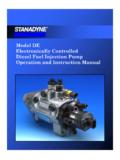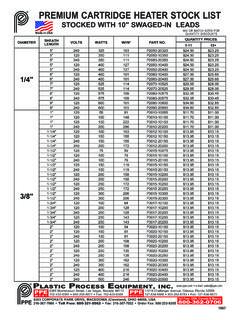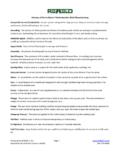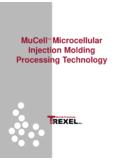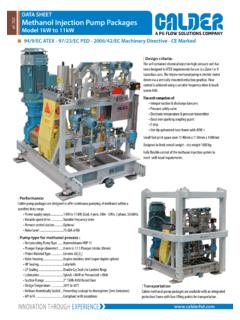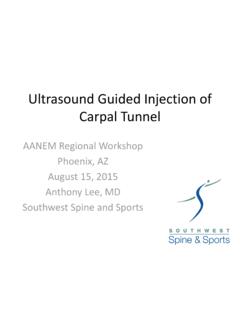Transcription of Introduction to Flow Injection Analysis (FIA)
1 CHEM 3211 Introduction to Flow Injection Analysis (FIA) Determination of Chloride Ion ConcentrationResponsible TA : Timo KikasFlow Injection Analysis PrinciplesFlow Injection Analysis (FIA) is based on the Injection of a liquid sample into amoving, nonsegmented continuous carrier stream of a suitable liquid. The injectedsample forms a zone, which is then transported toward a detector that continuouslyrecords the changes in absorbance, electrode potential, or other physical parameterresulting from the passage of the sample material through the flow 1. Four phases of FI AnalysisAn example of one of the simplest FIA methods, the spectrophotometricdetermination of chloride, is shown in Figure 2. This is based on the release ofthiocyanate ions from mercury(II) thiocyanate and its subsequent reaction with iron (III)and measurement of the resulting red color (for details, see Experiment).
2 The samples,with chloride contents in the range 5 -75 ppm chloride, are injected (S) through a 30 Lvalve into the carrier solution containing the mixed reagent, pumped at a rate of The iron(III) thiocyanate is formed on the way to the detector (D) in a mixingcoil ( m long, mm ), as the injected sample zone disperses in the carrier streamof reagent. The absorbance A of the carrier stream is continuously monitored at 480 nmin a micro flow-through cell (volume of 10 L) and recorded (Figure 2b). Todemonstrate the reproducibility of the analytical readout each sample in this experimentwas injected in quadruplicate, so that 28 samples were analyzed at seven differentconcentrations of chloride. As this took 14 min, the average sampling rate was 120samples / h.
3 The fast scan of the 75- and 30-ppm sample peaks (shows on the right inFigure 1b) confirms that there was less than 1% of the solution left in the flow cell at thetime when the next sample (injected at S2) would reach it, and that there was nocarryover when injecting the samples at 30-s 2. (a) Flow diagram for the specrophotometric determination of chloride: S is thepoint of sample Injection , D is detector, and W is waste. (b) Analog outputshowing chloride Analysis in the range of 5 - 75 ppm Cl- with the system depictedin (a).A key feature of FIA is that since all conditions are reproduced, dispersion is verycontrolled and reproducible. That is, all samples are sequentially processed in exactly thesame way during passage through the analytical channel, or in other words, what happensto one sample happens in exactly the same way to any other sample.
4 FIA is amicrochemical technique which consumes minute quantities of sample and reagents andtherefore generates less than 1 mL of waste per assay (Figure 2).The FIA SystemThe simplest flow Injection analyzer (Figure 3a) consists of a pump, which is usedto propel the carrier stream through a narrow tube; an Injection port, through which awell-defined volume of a sample solution S is injected into the carrier stream in areproducible manner; and a microreactor in which the sample zone disperses and reactswith the components of the carrier stream, forming a species which is sensed by a flow-through detector and recorded. A bypass loop allows passage of carrier when theinjection valve is in the load position.
5 A typical recorder output has the form of a peak(Figure 3b), the height H, width W, or area A of which is related to the concentration ofthe analyte. The time span between the sample Injection S and the peak maximum,which yields the analytical readout as peak height H, is the residence time t during whichthe chemical reaction takes place. A well-designed FIA system has an extremely rapidresponse, because T is in the range 5 - 20 s. Therefore, a sample cycle is less than 30 s(roughly T + tb) and thus, typically, two samples can be analyzed per minute. Theinjected sample volumes may be between 1 and 200 L (typically 25 - 50 L), which inturn requires no more than mL of reagent per sampling cycle.
6 This makes FIA asimple, automated microchemical technique, capable of a high sampling rate andminimum sample and reagent 3. (a) The simplest single line FIA manifold utilizing a carrier stream of reagent;S is the Injection port, D is the flow cell, and W is the waste. (b) The analogoutput has the form of a peak, the recording starting at S (time of Injection to). His the peak height, W is the peak width at a selected level, and A is the peak is the residence time corresponding to the peak height measurement, and tb isthe peak width at the , then, is based on a combination of three principles: sample Injection ,controlled dispersion of the injected sample zone and reproducible timing of itsmovement from the Injection point to the detector.
7 Thus, in contrast to all other methodsof instrumental Analysis , the chemical reactions are taking place while the samplematerial is dispersing with the reagent, that is, while the concentration gradient of thesample zone is being formed by the dispersion is a general solution-handling technique, applicable to a variety of tasksranging from pH or conductivity measurement to colorimetry, titrations, and enzymaticassays. To design any FIA system properly, one must consider the desired function to beperformed. For pH measurement, or in conductometry, or for simple atomic absorption,when the original sample composition is to be measured, the sample must be transportedthrough the FIA channel and into the flow cell in an undiluted form in a highlyreproducible manner.
8 For other types of determinations, such as spectrophotometry, theanalyte has to be converted to a compound measurable by a given detector. Theprerequisite for performing such an assay is that during the transport through the FIAchannel, the sample zone is mixed with reagents and sufficient time is allowed forproduction of a desired compound in a detectable the single line system, a variety of manifold configurations may be usedto allow application to nearly any chemical system. The two-line system (B) is the mostcommonly used, in which the sample is injected into an inert carrier, and then mergeswith the reagent. In this manner, the reagent is diluted by a constant amount throughout,even when the sample is injected, in contrast to the single line system.
9 Reagent dilutionby the sample in a single-line system is feasible so long as there is excess reagent (and D> 1) and the reagent does not exhibit a background response that would shift upondilution. If two reagents are unstable when mixed, they may be mixed on-line (C or D),or they may merge with the sample following Injection (E). Mixing coils may beinterspersed between confluence points to allow dispersion before SECTIONS ingle-line FIA: Spectrophotometric Determination of ChloridePrincipleThe analytical procedure is based on the following reactions:Hg(SCN)2 + 2Cl- HgCl2 + 2 SCN-2 SCN- + Fe3+ Fe(SCN)2+The carrier stream contains Hg(SCN)2 and Fe(III). The chloride of the injected samplereacts with Hg(SCN)2, liberating SCN-, which in turn forms with Fe(III) the red-coloredcomplex ion Fe(SCN)2+, which is measured spectrophotometrically at 480 nm.
10 Theheight of the recorded absorbance peak is then proportional to the concentration ofchloride in the sample. Besides Fe(SCN)2+, other (higher) complex ions between Fe(III)and SCN- might be formed; thus, the calibration curve cannot be expected to be linearover a wide range of : The reagent used is toxic, since it contains mercury. Collect the wastefor safe disposal. Since FIA generates much smaller amounts of waste than manualprocedures, the volumes of waste produced will be easily manageable. Further reductionof waste can be accomplished by neutralizing the waste with an excess of sodiumhydroxide and subsequent coprecipitation of Fe2S3 and HgS with 4. Experimental and Chemicals RequiredReagent. The carrier stream is prepared by dissolving g of mercury(II)thiocyanate, g of iron(III) nitrate, mL of concentrated nitric acid, and 150 mL ofmethanol in water, making the final volume up to 1 Solutions.




